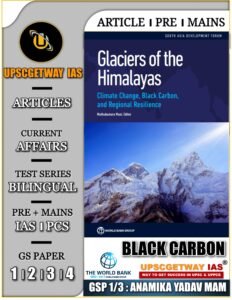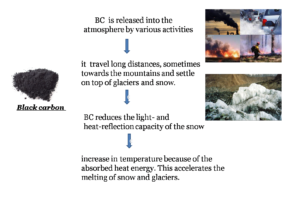World bank report on Black Carbon impact on Enviornment
यदि उपमहाद्वीप उत्सर्जन में कटौती करते हैं तो उच्च एशिया में ब्लैक कार्बन 23% कम हो सकता है: विश्व बैंक रिपोर्ट

ग्लेशियरों पर जमा ब्लैक कार्बन बर्फ की रोशनी और गर्मी परावर्तन क्षमता को कम कर देता है, जिससे यह पिघल जाता है।
मुख्य विशेषताएं :
- यदि दक्षिण एशियाई देश सभी मौजूदा ब्लैक कार्बन (बीसी) उत्सर्जन नीतियों को लागू करते हैं, तो प्रदूषक का जमाव 23 प्रतिशत तक कम हो सकता है- विश्व बैंक समूह द्वारा 3 जून को जारी नई रिपोर्ट।
- रिपोर्ट में पाया गया है कि दुनिया भर में ग्लेशियर और बर्फ के पिघलने में 50 प्रतिशत तक की वृद्धि के लिए बीसी(BC) जमाव जिम्मेदार है।
 ब्लैक कार्बन कैसे बनता है ?
ब्लैक कार्बन कैसे बनता है ?
- बीसी कार्बन युक्त ईंधन (लकड़ी, कोयला, पेट्रोल, डीजल आदि) के अधूरे जलने से उत्पन्न होता है।
- प्रदूषक कई मानवीय गतिविधियों जैसे उद्योगों, वाहनों, बायोमास जलने, जंगल की आग, ईंट बनाने और चूल्हे से उत्पन्न होता है।
चिंताजनक तथ्य :
- हाल के वैज्ञानिक प्रमाणों के अनुसार, पश्चिमी क्षेत्रों में हिंदू कुश, हिमालय और काराकोरम पर्वतमाला में हिमनद प्रति वर्ष 3 मीटर की दर से पीछे हट रहे हैं।
- पूर्वी क्षेत्रों में प्रति वर्ष एक मीटर पर तीन बार से अधिक पीछे हटना है।
- एक शोध पत्र में पाया गया कि माउंट एवरेस्ट क्षेत्र के ग्लेशियर 2050 तक 39-52 प्रतिशत तक कम हो सकते हैं।
- “हिमालय में ब्लैक कार्बन और ग्लेशियर के पिघलने और मध्य-पहाड़ों में अनियमित वर्षा से हमेशा निचले इलाकों में भूस्खलन, बाढ़ और बाढ़ आती है।
- बीसी बादल छाए रहने और मानसूनी वर्षा को बाधित करता है।
अन्य तथ्य :
- ब्लैक कार्बन, जिसे आमतौर पर कालिख (soot) के रूप में जाना जाता है।
- यह एक अल्पकालिक प्रदूषक है जो कार्बन डाइऑक्साइड (CO2) के पीछे ग्रह को गर्म करने में दूसरा सबसे बड़ा योगदानकर्ता है।
- अन्य ग्रीनहाउस गैस उत्सर्जन के विपरीत, बीसी जल्दी से धुल जाता है और अगर उत्सर्जन बंद हो जाता है तो इसे वातावरण से समाप्त किया जा सकता है। ब्लैक कार्बन केवल कई दिनों से लेकर हफ्तों तक वायुमंडल में रहता है।
- भारत और चीन विश्व में ब्लैक कार्बन के सबसे बड़े उत्सर्जक हैं।
ब्राउन कार्बन
- यह मुख्य रूप से बायोमास दहन द्वारा कार्बनिक पदार्थों के दहन से निकलने वाला भूरा धुआँ है।
हरा कार्बन
- यह कार्बन है जिसे स्थलीय पारिस्थितिक तंत्र द्वारा लिया जाता है, इसलिए पारिस्थितिक तंत्र में कार्बन का वह भाग जो प्रकाश संश्लेषण द्वारा वायुमंडल से हटाया जाता है, उसे हरा कार्बन कहते हैं
नीला कार्बन
- यह तटीय और समुद्री पारिस्थितिक तंत्र में संग्रहित कार्बन है।
- मैंग्रोव, ज्वारीय दलदल, और समुद्री घास घास के मैदान जैसे तटीय पारिस्थितिकी तंत्र स्थलीय वनों की तुलना में प्रति इकाई क्षेत्र में अधिक कार्बन जमा करते हैं और अब जलवायु परिवर्तन को कम करने में उनकी भूमिका के लिए पहचाने जा रहे हैं।
समतुल्य ब्लैक कार्बन (EBC) :
- ब्लैक कार्बन अपने उत्पति स्रोत के आधार पर अलग-अलग प्रकार के होते हैं तथा वे प्रकाश के विशिष्ट तरंगदैर्ध्य का अवशोषण या परावर्तन करते हैं। इसका मापन ऐथेलोमीटर (Aethalometers) उपकरण द्वारा किया जाता है।
- ब्लैक कार्बन के इन मौलिक कणों को द्रव्यमान (Mass) इकाई में बदलने के लिये, इन उपकरणों का उपयोग किया जाता है तथा परिणाम को समतुल्य ब्लैक कार्बन (EBC) नाम दिया जाता है। यथा- यातायात के ब्लैक कार्बन द्रव्यमान को EBC-TR लिखा जाएगा।
ब्लैक कार्बन के स्रोत: ऊपर चित्र देखें

ब्लैक कार्बन के प्रभाव :
- वायुमंडल में इसके अल्प स्थायित्व के बावजूद यह जलवायु, हिमनदों, कृषि, मानव स्वास्थ्य पर व्यापक प्रभाव डालता है।
- वैज्ञानिकों के एक समूह द्वारा समतापमंडल (stratosphere) में 18 किमी. की ऊँचाई तक इन कणों के उपस्थित होने के साक्ष्य मौजूद हैं। इसका प्रभाव यह होता है कि ये ब्लैक कार्बन कण लंबे समय तक वातावरण में उपस्थित रहते हैं तथा ‘ओज़ोन परत को नुकसान’ पहुँचाने वाली अन्य रासायनिक प्रतिक्रियाओं के लिये एक बेहतर स्थिति प्रदान करते हैं।
- बेल्ज़ियम की हैसेल्ट यूनिवर्सिटी के वैज्ञानिकों की एक टीम ने ब्लैक कार्बन कणों से जुड़ा एक अध्ययन जारी किया, जिसके अनुसार प्रदूषित हवा में मौजूद ब्लैक कार्बन जैसे वायु प्रदूषक में गर्भवती माँ के फेफड़ों के माध्यम से प्लेसेंटा में स्थापित होने की क्षमता होती है जिसके ‘शिशु पर गंभीर स्वास्थ्य परिणाम’ प्रदर्शित होते हैं।
हिमनद व परमाफ्रास्ट (Permafrost) पर प्रभाव :
- वर्ष 2005 में प्रकाशित लारेंस रिपोर्ट के अनुसार, आर्कटिक क्षेत्र में समस्त मृदा का लगभग 30% ब्लैक कार्बन भंडार है। वैश्विक तापन के कारण हिमनद तथा परमाफ्रास्ट लगातार पिघल रहा है तथा इसमें दबा हुआ ब्लैक कार्बन और मीथेन बाहर आ रही है जिससे जलवायु तापन में और तेज़ी आएगी।
- ब्लैक कार्बन के कारण ‘हिमालयी ग्लेशियरों’ पिघलने की गति भी बढ़ गई है।

Black carbon in High Asia can go down 23% if Subcontinent cuts emissions: Report
Black carbon deposited on glaciers reduces snow’s light and heat reflection capacity, making it melt.
Highlights :
- If South Asian countries implement all the current Black Carbon (BC) emission policies, the deposition of the pollutant can go down by 23 per cent- New report released by the World Bank Group June
- The report finds that BC deposition is responsible for as much as 50 per cent of the increase in glacier and snow melt worldwide.
How Black carbon is produced?
- BC is produced by the incomplete burning of carbon-containing fuels (wood, coal, petrol, diesel etc)
- The pollutant is generated by a range of human activities such as industries, vehicles, biomass burning, forest fires, brick-making, and cookstoves.
Worrying facts :
- According to recent scientific evidence, the glaciers in the Hindu Kush, Himalayan and Karakoram ranges are retreating at a rate of 3 metre per year in the western regions.
- The retreat is more than thrice at one metre per year in the eastern regions.
- One research paper found that glaciers in the Mount Everest region might reduce by 39-52 per cent by
- “Black carbon and glacier melting in the Himalayas and erratic rainfall in the mid-mountains always lead to landslides, floods and inundation in the lowlands
- BC disrupts cloudiness and monsoon rainfall.
Other facts :
- Black carbon, commonly known as soot.
- It is a short-lived pollutant that is the second-largest contributor to warming the planet behind carbon dioxide (CO2).
- Unlike other greenhouse gas emissions, BC is quickly washed out and can be eliminated from the atmosphere if emissions stop.[ Black carbon stays in the atmosphere for only several days to weeks.
- India and China are the largest emitters of black carbon in the world.
Brown carbon :
- it is brown smoke released by the combustion of organic matter mainly by biomass combustion.
Green carbon :
- It is the carbon that is taken up by terrestrial ecosystems, so ecosystems on land.
Blue carbon :
- It is the carbon stored in coastal and marine ecosystems.
- Coastal ecosystems such as mangroves, tidal marshes, and seagrass meadows sequester and store more carbon per unit area than terrestrial forests and are now being recognized for their role in mitigating climate change.
Equivalent Black Carbon (EBC) :
- Black carbons are of different types depending on their source of origin and they absorb or reflect specific wavelengths of light. It is measured by the instrument Aethalometers.
- To convert these fundamental particles of black carbon into units of mass, these devices are used and the result is named equivalent black carbon (EBC). For example, the black carbon mass of the traffic will be written as EBC-TR.
Sources of black carbon : See picture in hindi content
Effects of Black Carbon :
- A team of scientists from Belgium’s Hasselt University released a study involving black carbon particles, according to which air pollutants such as black carbon present in polluted air have the ability to settle in the placenta through the pregnant mother’s lungs. ‘Serious health consequences’ on the infant are displayed.
- Despite its low stability in the atmosphere, it has a wide impact on climate, glacial, agriculture, human health.
- 18 km in the stratosphere by a group of scientists. There is evidence of the presence of these particles up to a height of . The effect of this is that these black carbon particles are present in the atmosphere for a long time and provide a better condition for other chemical reactions that ‘damage the ozone layer’.
Effect on glaciers and permafrost :
- According to the Lawrence Report published in the year 2005, about 30% of the total soil in the Arctic region is black carbon reserves. Due to global warming, glaciers and permafrost are melting continuously and buried black carbon and methane are coming out, which will further accelerate climate warming.
- The rate of melting of ‘Himalayan glaciers’ has also increased due to black carbon.
उपरोक्त लेख के आधार पर मुख्य परीक्षा तथा प्रारम्भिक परीक्षा पर कुछ प्रश्न अभ्यास हेतु
- ब्लैक कार्बन क्या है और यह जलवायु परिवर्तन के लिए कैसे जिम्मेदार है? इसके अलावा, विश्व बैंक द्वारा प्रकाशित नवीनतम रिपोर्ट पर चर्चा करें जिसके अनुसार ब्लैक कार्बन पर मजबूत नीतियां ग्लेशियर के पिघलने को तेजी से कम कर सकती हैं, टिपण्णी करें
- What is black carbon and How does it responsible for climate change? Also, discuss the latest report published by the world bank which says strong policies on black carbon can sharply deacrease glacier melt
- ब्लैक कार्बन तथा इनके प्रकारों के सन्दर्भ में दिए गए गए कथनों पर विचार कीजिये-
1) ब्लैक कार्बन को प्रायः कालिख (Soot) के नाम से भी जाना जाता है
2) ब्लैक कार्बन के विभिन्न प्रकारों का मापन ऐथेलोमीटर (Aethalometers) उपकरण के द्वारा किया जाता है
3) भारत विश्व में सबसे ज्यादा ब्लैक कार्बन उत्सर्जित करने वाला देश है
उपर्युक्त दिए गए कथनों में कौन-सा/से कथन सत्य है/हैं?
a) 1 और 3
b) 1 और 2
c) केवल 3
d) 2 और 3
उत्तर : b
Download pdf of this article:

0 Comments